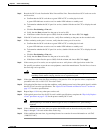
2-57
Cisco ONS 15327 Troubleshooting Guide, R3.4
March 2004
Chapter 2 Alarm Troubleshooting
Alarm Procedures
Step 5 Record the OC-N cards listed under West Line and East Line. Ensure that these OC-N cards are active
and in service:
a. Confirm that the OC-N card shows a green LED in CTC or on the physical card.
A green LED indicates an active card. An amber LED indicates a standby card.
b. To determine whether the OC-N port is in service, double-click the card in CTC to display the card
view.
c. Click the Provisioning > Line tabs.
d. Verify that the State column lists the port as in service (IS).
e. If the State column lists the port as OOS, click the column and choose IS. Click Apply.
Step 6 If the OC-N cards are active and in service, verify fiber continuity to the ports on the recorded cards.
Step 7 If fiber continuity to the ports is correct, verify that the correct port is in service:
a. Confirm that the OC-N card shows a green LED in CTC or on the physical card.
A green LED indicates an active card. An amber LED indicates a standby card.
b. To determine whether the OC-N port is in service, double-click the card in CTC to display the card
view.
c. Click the Provisioning > Line tabs.
d. Verify that the State column lists the port as in service (IS).
e. If the State column lists the port as OOS, click the column and choose IS. Click Apply.
Step 8 If the correct port is in service, use an optical test set to verify that a valid signal exists on the line.
For specific procedures to use the test set equipment, consult the manufacturer. Test the line as close to
the receiving card as possible.
Caution Using an optical test set disrupts service on the optical (traffic) card. It might be necessary to
externally switch traffic carrying circuits over to a protection path.
Step 9 If the signal is valid, clean the fiber according to site practice. If no site practice exists, complete the
procedure in the Cisco ONS 15327 Procedure Guide.
Step 10 If cleaning the fiber does not clear the condition, verify that the power level of the optical signal is within
the OC-N card’s receiver specifications. The “Optical Card Transmit and Receive Levels” section on
page 1-77 lists these specifications.
Step 11 Repeat Steps 6–10 for any other ports on the card.
Step 12 If the optical power level for all OC-N cards is within specifications, complete the “Physically Replace
a Card” procedure on page 2-130 for the protect standby OC-N card.
Note When replacing a card with an identical type of card, no additional CTC provisioning is
required.
Step 13 If the condition does not clear after you replace the BLSR cards on the node one by one, follow
Steps 4 through 12 for each of the nodes in the ring.
Step 14 If the condition does not clear, log onto http://www.cisco.com/tac for more information or call TAC
(1-800-553-2447).


















